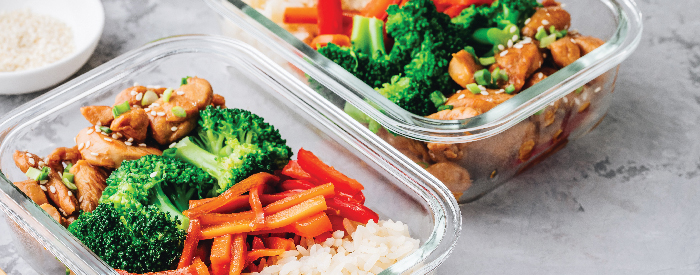SAVE TIME AND EAT BETTER WITH MAKE-AHEAD MEALS
Tips to get you started with meal prepping

Meal prepping — preparing whole meals ahead of time — has become popular among busy people and those on a budget, because it can save you a lot of time and money. It’s also a great way to have nutritious meals on hand when you need them.
If you are busy caring for kids or aging parents, trying to lose weight or eat better, or feeling overwhelmed, having prepared meals on hand can help you manage your food choices and portion sizes. Since meal prepping requires you to determine what you will eat ahead of time, it can lead to more nutritious meals over the long term for you and your family.
Meal prepping may seem like it takes up a lot of time, but according to the USDA, Americans spend 31 minutes preparing meals each day — and for women, that jumps up to 51 minutes. The Harvard School of Public Health has found that incorporating meal prepping into your week can ultimately save time and reduce stress. There are various ways to meal prep — and not all of them involve spending a whole Sunday afternoon cooking. Try some of the following tips and see what works best for you.
Determine your style. There are a variety of meal prep styles. Find the one that works for your daily routine and goals:
- Batch cooking: Make large batches of a specific recipe, then split it into individual portions to be frozen — like the soup recipe on this page!
- Individually portioned meals: Prepare fresh meals and portion them into individual grab-and-go containers to be refrigerated and eaten over the next few days.
- Ready-to-cook ingredients: Prep ingredients, like pre-cutting fruit, veggies & salad greens, or roasting a chicken to cut down on cooking time and have healthy snacks on hand.
Find recipes you like. If you are cooking for your family, discuss what types of foods and favorite meals they like to eat. And be sure to pick recipes that match your cooking experience and schedule. Don’t like to cook? That’s ok — you can find plenty of no- or low-cook options.
Buy the right storage containers. You don’t have to spend a lot of money, but having containers that travel well, and are microwave and dishwasher safe, goes a long way in helping you become a successful meal prepper. If you search online for “meal prep containers” you’ll find a wide range of options. Find what works best for you and your budget.
Need inspiration? Click here for 30 days of meal ideas, tips on containers, and information on food safety.
Sources: www.usda.gov, www.hsph.harvard.edu
